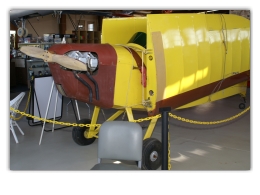
| ||||
|---|---|---|---|---|
 |
 |
 |
 |
 |



























| ||||
|---|---|---|---|---|
 |
 |
 |
 |
 |


























Bowers Fly Baby
United States — small homebuilt monoplane
Archive Photos
1988 Bowers "Fly Baby" (N9767N, s/n 87-491) at the Santa Maria Museum of Flight, Santa Maria, CA (Mfg. by EAA -491) (Photos by John Shupek)

Overview 2
The Bowers Fly Baby is a homebuilt, single-seat, open-cockpit, wood and fabric low-wing monoplane that was designed by famed United States aircraft designer and Boeing historian, Peter M. Bowers.
Development 2
The prototype Fly Baby first flew in 1962. It is now on display at the Museum of Flight in Seattle.
Variants included a biplane version called the Bowers "Bi-Baby" or "Fly Baby 1-Band" several dual cockpit designs by various builders. Bowers also designed a side-by-side two-seat version he called "Namu", but few examples have been built.
The "Fly Baby" was the winner of the Experimental Aircraft Association’s 1962 design competition. Over 500 Fly Babies have been completed to date, with scores still flying worldwide and an active network of builders and owners. It is built from plans and was designed to be constructed in a garage using only basic hand tools, by a person of average "home handyman" skill in 1962. The plans consist of over one hundred pages of typewritten instructions and dimensioned drawings. After Bowers death in 2003 the plans were unavailable for a time, but as of 2007 they were available again.
Regulations 2
USA
In the United States of America the FAA categorizes the "Fly Baby" as an Experimental Amateur-Built aircraft. It also fits the FAA’s specifications for a Light Sport Aircraft and can be flown in the US by pilots holding a Recreational Pilot or Sport Pilot certificate.
Canada
In Canada the Fly Baby may be built as an amateur-built aircraft or as a basic ultra-light aeroplane. It may be flown with an Ultra-light Pilot Permit or higher aeroplane licence.
Design 2
The Fly Baby was designed to be a very simple aircraft. For example, the fuel gauge is a stiff wire attached to a float poking up through the gas cap (a common application in the 1930s and 1940s, as seen on Piper and Aeronca light aircraft). The structure is of aircraft-grade spruce and plywood, covered with fabric. Aileron controls are push-tube, elevator controls are a combination of push-tube and cable, the rudder is cable-controlled.
The landing gear is fixed and unsprung. The main landing gear struts are made of laminated wood with a steel axle. The only shock absorption comes from the tires themselves. Hydraulic wheel brakes are usually fitted.
The aircraft was designed to be powered by a 65 horsepower (48 kW) Continental A-65 piston engine taken from a Piper Cub. Engines of up to 100 horsepower (75 kW) have been fitted, including the Continental O-200 and converted Corvair engines.
While the instrumentation installed is up to the builder, most Fly Babys are equipped for visual flight rules (VFR) only. An electrical system is optional; many Fly Baby owners hand-prop the engine for starting, and use a handheld radio.
The Fly Baby’s wings fold up against the fuselage enabling it to be stored in a single-car garage or a car trailer. The wings can be folded or unfolded in about 15 minutes. The airplane was designed to be stored in a garage and towed to the airport on its own gear. In practice, most owners use a trailer or keep their Fly Baby hangared at an airport.
A Fly Baby can be converted to a biplane "Bi-Baby" in less than one hour by adding the struts and upper wing to the existing aircraft (if the fittings were built in) or it can be built as a biplane version from the start.
Some of the components used, such as the fuel tank and engine, were designed to be taken from the Piper Cub, which were cheap and plentiful in 1962. Even today, the total cost of construction can be under US$10,000.
"Fly Baby" Specifications 2
General Characteristics
Performance
"Bi Baby" Specifications 2
General Characteristics
Performance
References